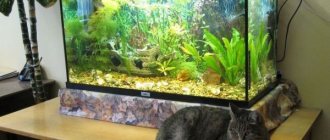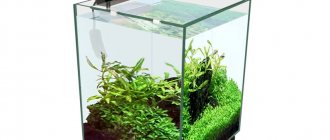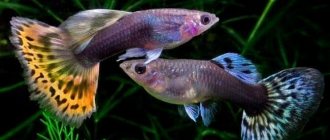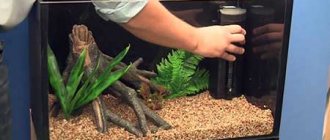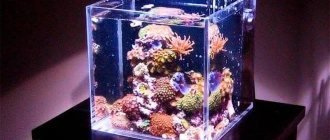Home › Aquarium equipment ›
( 1 ratings, average: 4.00 out of 5)
Aquariums of 30 - 40 liters are the most common home aquariums. What is the reason for such popularity?
Maybe you are a beginner and just decided to try yourself in a new hobby? Or are you not yet sure that you will not give up this idea? Then this is the right choice.
30 liters or 40 is a small volume of water. Not every novice aquarist will decide to purchase a large aquarium right away. A large capacity takes up a lot of space, and this is very important if you have a small apartment.
Equipment also takes up a lot of space - external filters, CO2 generator. In addition, a large aquarium means a larger volume of water that you will have to work with and make regular changes.
On the other hand, an aquarium with a volume of 30 to 40 liters is already a fairly large container. In such an aquarium you can plant more plants, add more fish and shrimp, have more space for decoration, and the environment in it will be more stable than in a 10-20 liter tank, which means there is a greater chance of a long-term existence of a mini aqua system.
An aquarium of 30-35-40 liters is a fairly small budget expenditure, but it is a full-fledged, albeit small, living world with a diverse population. This is a good choice for a beginner aquarist.
Choosing an aquarium
The classic shape for an aquarium with a capacity of 40 liters is rectangular. It can be low or high, narrow and long or with square walls. Most often, the parameters of such a large jar are 24-30 cm in width and height, 50-72 cm in length. These dimensions allow you to freely place the vessel on a cabinet, table, or cabinet niche. A long narrow container can be used as a decorative partition when zoning a room. Standard aquariums are made of dense and heavy silicate glass that is resistant to damage.
There are original round and hexagonal aquariums. When making vessels of unusual shapes, acrylic is used - a light and pliable material. Products made from it quickly become cloudy and lose their attractive appearance. That is why spherical jars with a volume of 40 liters or more are not recommended for use. They are difficult to treat from plaque, and also to equip them with a life support system.
Types of aquariums
Aquariums from 30 liters most often have a length of 45 cm, a width of 25 cm and a height of 25 cm.
Shapes can be different: cubic, rectangular, with convex walls.
Material: glass, acrylic, highly transparent glass. It is better to give preference to glass - it is a more durable material, it does not scratch when cleaning algae from the walls. Also, glass remains transparent for a long time, while acrylic can turn yellow from sunlight. Acrylic, however, is a lighter material; in some cases it should be preferred.
Often such aquariums are sold together with equipment - lighting and filter.
The cost of equipment is usually low, which allows beginners to try a new hobby without spending too much money.
Beginners should understand that controlling balance and maintaining cleanliness and stability is much easier in larger aquariums. You have to take care of a 30-40 liter aquarium more often than larger ones.
Let's consider several options from best manufacturers.
Aquael SHRIMP SET SMART 30 liters
This aquarium is from the SET SMART line of Aquael aquariums, designed for breeding shrimp and small fish.
Size
29 x 29 x 35 cm.
Equipment
The kit includes an aquarium tank, a cover glass, a protective lining for the tank, an LED lamp, an inner filter, a heater, and shrimp food.
Description
A beautiful cubic aquarium. You can keep it not only shrimp, but also small fish, including betta. The composition includes almost everything you need, you just need to buy some soil.
Tetra AquaArt Aquarium Complete Set Discover Line 30 liters
Size
39 x 27.5 x 42.2 cm
Equipment
- Durable, distortion-free float glass container.
- Innovative Tetra EasyCrystal filter.
- Cover with 8 W T8 fluorescent lamp.
Description
This is an option from Tetra for keeping tropical aquarium fish. There are also other 30 liter options: Tetra AquaArt LED Aquarium 30L Goldfish for keeping goldfish with an LED lamp, Tetra AquaArt LED Explorer Line 30L White Edition - a white aquarium for keeping crayfish and crustaceans with a curved front wall.
Aquariums Nature
Dimensions
Capacities 32, 34, 40 liters.
Equipment
A rectangular glass container with a flat or oval front glass.
Cover with fluorescent lamps.
Description
High-quality inexpensive aquariums from a Kharkov manufacturer.
Equipment
Before starting an aquarium of any size in which plant decoration is planned, you need to think about lighting. The size and power of the lamps are chosen taking into account the dimensions of the container. Both the volume of water and the depth are important - the rays of light should cover all plants, but excessive power can cause the growth of greenery. The lamp may be an integral part of the cover.
The filter is designed to purify water from food residues, waste of fish and other waterfowl. In addition, it is needed to maintain biobalance through a special substrate. The filtration system can be primitive - in the form of a foam sponge, or complex - an external filter with a compartment for filler. Several hundred liters of water can be pumped through the filter elements per hour, depending on the power of the device.
To maintain the temperature you will need a heater and a thermometer. It is more comfortable for fish to live in warm water – 22-26 ºC. A constantly running low-power heater (1 W per 1 liter of water) or a device with a thermostat that turns off after the water temperature reaches a set parameter is suitable. It is recommended to place the thermometer and thermostat on opposite walls of the aquarium.
Oxygen is supplied by a compressor: a stream of oxygen in the form of tiny bubbles enters the water through a sprayer. This device is selected based on two parameters: performance and noise level. For a 40-liter aquarium, a compressor producing 20 liters per hour will be sufficient. You need to check how noisy it is in the store when purchasing. A sprayer is placed at the bottom of the can, to which a hose is attached and led to a compressor attached to the outside.
Attention! Properly selected components help to establish biochemical processes in the aquarium. All equipment must work constantly, only the lights can be turned off periodically at night.
Glass sizes for making an aquarium
The following is a calculation of the glass sizes to be cut for making an aquarium with your own hands or ordering it from a workshop.
- Glass: 5mm
- Front glasses: 400 x 350 = 2 pcs
- Side windows: 290 x 350 = 2 pieces
- Aquarium bottom: 386 x 288 = 1 piece
- Stiffening ribs: 290 x 50 = 2 pcs
Cover glass for aquarium
Additionally, a 4 mm thick cover glass is included in the kit. Glass will reduce water evaporation and extend the service life of the lighting (it will eliminate the collection of condensation under the aeration cover).
- Glass: 4 mm
- Cover glass: 380 x 280 = 1 piece - cut 2 corners 50 x 50 mm
Decor
A transparent vessel with water and equipment does not make the right impression, even if gorgeous fish swim in it. Proper filling of the reservoir will help disguise the life support system and create a comfortable space for waterfowl.
Important point! You need to decide on the design before filling the aquarium with water.
In the aquarium hobby there are several types of decor: tropics, pseudosea, herbalist and other options. You can implement your chosen design idea using soil, decorations and background images.
- The background is most often a film glued to one of the walls. The picture can be flat or three-dimensional, made of foamed polymer.
- The soil is intended to strengthen and nourish plants. Nutrient soil is made of clay, peat particles and is needed if there is living decor in the aquarium. The thinnest layer of soil is located at the front glass and gradually increases towards the far wall.
- The decorations are stones and driftwood, figurines, shells. Fish may be hiding in them. You can lay out complex compositions from stones and driftwood, while avoiding a disorderly pile-up. The front wall is left free of decorations to make it easier to observe the fish.
Decorating a 40-liter aquarium is an interesting activity that helps to show imagination and realize creative abilities.
Starting an aquarium
Immediately after installation, the aquarium is not ready to receive the population. The fact is that bacteria must first settle in it, processing fish waste products: breaking down ammonia into nitrites, and them into less dangerous nitrates. This process is called the nitrogen cycle, and starting an aquarium means allowing the nitrogen cycle to establish itself. The nitrogen cycle can take from 2 to 8 weeks to establish.
There are different options for starting an aquarium. There is an opinion that the container only needs to be left alone for this period, and the cycle will start. However, for the necessary bacteria to appear, they first need food - ammonia, and if there are no fish, then there is no food. Therefore, bacteria may not appear for a long time, especially in the required quantity. What to do?
Option 1: Add ammonia yourself at 2-4 ppm every few days. Then the water is tested using tests for the presence of harmful substances (ammonia, nitrites, nitrates). In a neglected aquarium, only nitrates can be in the water; there should be no other decomposition products, as well as ammonia itself. This is not the best option because it is difficult to determine the right amount of ammonia.
Option 2. Add preparations containing bacteria to start the aquarium. In this case, the bacteria again need food, and ammonia must be added. And there is an opinion that such drugs are a product of commercial PR and are little effective, if at all useful.
Option 3. Gradual biological filling. I believe that this is the safest and most effective way to start an aquarium. In this case, it is recommended to introduce fish (or shrimp) gradually, not all at once. In the first week, 1/3 of the maximum population - so the ammonia that appears in the water will be the least toxic to fish. After a week, the water is tested. If ammonia is not detected, the aquarium population is replenished.
Thus, the nitrogen cycle is established quickly enough and is least dangerous for the population.
Plants
A large-capacity pond is easier to decorate than a small vessel. If a 10-liter jar contains only 2-3 types of herbs, then the choice of plants for a 40-liter aquarium increases significantly. However, fast-growing species should be excluded, otherwise soon all the space will be occupied by greenery.
Can:
- ferns;
- Echinodorus;
- small cryptocorynes;
- marsilia;
- staurogyne;
- Anubias.
Not recommended:
- cryptocorynes of large species;
- aponogeton;
- Eichornia.
The aquarium is planted with plants, starting from the middle. Low bushes and rosettes are placed there. Long stems are planted on the sides. The composition is completed with “intermediate-connecting” elements, for example, mosses.
Live aquarium plants
An aquarium of 30 liters or 40 liters is already quite a spacious container, so the choice of plants expands significantly. You just need to avoid large species.
Excluded
- aponogetones;
- large species of Echinodorus;
- large cryptocorynes;
- too large, fast-growing, long-stemmed aquarium plants.
Can be planted
- All types of aquatic mosses.
- All ferns except large ones (bolbitis gedeloti).
- Rosette plants: small and medium-sized Cryptocorynes, Echinodorus, Nymphoides, Vallisneria, Blyxa, Pogostemon helfera, Eriokauron sinerium and other small plants.
- All types of ground cover: Marsilia, Micrantemum Monte Carlo, Lilaeopsis, Hydrocotyla tripartira, Staurogyne, Hemianthus cube and many others.
- Long-stemmed. Many aquarium plants are suitable for keeping, especially in a 40-liter aquarium, but avoid large and fast-growing species - they can take up all the available space in a short time (especially in good lighting). And floating on the surface they will shade the entire space below.
- Anubias.
- Bucephalandra.
How many and what kind of fish can you keep in a 40 liter aquarium?
Fish need free space, otherwise overpopulation occurs and the balance of the ecosystem is upset. When calculating the number of fish that can be kept in a 40-liter aquarium, you need to take into account the minimum requirements: small species require 1 liter of water per individual, medium - 4 liters, and large - 13 liters.
Approximate number of fish for a 40 liter aquarium:
- Neons are small and bright tropical fish. They live in flocks and can comfortably exist in a group of 20-25 individuals of various colors. Peace-loving neons should not be kept together with large barbs, gouramis, goldfish and catfish.
- Pecilia is a viviparous fish about 5 cm in size. It is unpretentious, has good health, and can live with guppies, gourami, and zebrafish. For a 40-liter aquarium, the planting density of platies is 6-8 pieces.
- Swordtails are distinguished by an elongated caudal fin. Ideal pets for beginners in the aquarium hobby. Swordtails are compatible with peaceful, medium-sized fish and bottom dwellers. One company can have 10 individuals.
- Guppy is a small fish with a narrow long body and a bushy tail. Males are smaller, brighter and slimmer than females, and they also have a gonopodium - a reproductive organ. A pond with a capacity of 40 liters can accommodate 10-15 guppies.
- Goldfish is an artificially bred freshwater species of ray-finned fish that lives only in aquariums. There should not be more than one goldfish in a 40 liter jar, otherwise there may be a lack of oxygen.
- Gourami is a genus of labyrinth fish, called “threaders” due to their chain of ventral fins. Aquarium gourami grow up to 10 cm, so their number in a 40-liter aquarium should not exceed 6 pieces.
- Rasbora is an agile ray-finned fish with original colors and a size of 4-5 cm. It lives peacefully with neons, guppies, and tetras. The optimal accommodation option is a 40 liter aquarium. You can place a flock of up to 10 rasbors in it.
- Danios are fast, zebra-colored fish that live in schools. They are very popular among breeders because of their beautiful colors, and bioluminescent hybrids are especially delightful. The volume of an aquarium of 40 liters is sufficient to place 6-8 zebrafish in it.
- Catfish Corydoras is an armored catfish with a pointed head and a barrel-shaped body, flat underneath. It is considered an aquatic “orderly”, as it lives on the bottom and feeds on the remains of common food, cleans the walls of plaque. They like to hide, the presence of shelters is important to them. Two catfish per 40 liters will be enough.
- Cardinals are schooling fish that resemble neons in appearance. They swim in the middle and upper layers of water, taking food from the surface. They get along with peace-loving fish, they can be combined with rasboras, guppies, and zebrafish. It is recommended to have a flock of cardinals of at least 15 pieces.
Different types of fish in one aquarium look attractive, but the inhabitants themselves do not always like this proximity. If you think about the peace of fish, the most correct decision would be to buy a school of one species.
Even if you really like a certain type of fish, you shouldn’t take dozens of them. For example, guppies reproduce quickly, and bettas like to be alone. Therefore, when planning to place fish in a 40-liter aquarium, you should first think through the nuances: soil conditions, plants, compatibility and other parameters.
Aquarium 40 liters: description, lighting, compressor, photo, video.
So far we have looked at small aquariums that are suitable for aquarium hobbyists who do not have much experience with aquariums. And now, everything is going well, or you have already had experience in installing and maintaining an aquarium, and you want to start an aquarium with a larger capacity: get new pets or transplant existing ones into a larger space.
Contrary to the popular belief that the larger the aquarium, the more hassle it will take, we have been convinced more than once that the opposite is true. It is much more difficult to provide a stable life support system for its inhabitants in a small aquarium due to its small parameters. You can read a huge number of articles about how the first aquarium should be one hundred liters, that three cichlids require almost a whole sea of water, and shrimp should live exclusively in huge spaces. All this is a fallacy. The main thing is that if there is a normal supply of oxygen to the aquarium water, the water is well filtered, the temperature is optimal for a certain type of fish, and the necessary lighting is present. And yet, the care of different types of aquariums differs radically, which is mainly due to the conditions for keeping their inhabitants. What is special about a 40 liter aquarium? How to equip it and what is needed for its long existence? Let's try to figure out all these questions this time.
Compressor
In some cases, this device can be called the “heart” of any vessel. This device performs one of the most important functions for maintaining the life of not only fish, but also vegetation. A compressor is necessary to saturate the water with oxygen. It is installed, as a rule, in the outer part of the aquarium, both on the side and on its back. After this, you need to connect a special hose to it, which is subsequently lowered to the bottom and connected to the sprayer. Compressors can be of several types. Depending on the installation location: internal and external. If we talk about power, then: using batteries or operating from the mains.
One of the most common mistakes made by inexperienced aquarists is turning off the compressor at night. It is this act, which outwardly seems quite logical, that can lead to irreparable consequences, since it is at night that oxygen consumption increases significantly. Also, due to the suspension of photosynthesis processes, many plants begin to use carbon dioxide.
This device is also necessary for high-quality operation of the filter. It is worth emphasizing that even the presence of a large amount of vegetation in the aquarium does not lead to complete oxygen saturation of all inhabitants of the underwater world. And this is especially evident when the inhabitants of the vessel are not only fish, but also shrimp or even crayfish. Also, many experienced aquarists advise testing its operation on a container with vegetation before starting to install the compressor.
Important! It is necessary to constantly ensure that such a phenomenon as oxygen oversaturation does not occur.
Heater and thermometer
Another important attribute in maintaining the normal functioning of any aquarium is the constant maintenance of the required temperature. It is very difficult to overestimate the importance of a stable temperature in a vessel, since any sudden change in it can introduce a serious imbalance into the measured life of its inhabitants. As a rule, ideal values are considered to be between 22-26 degrees. If tropical fish are planned as residents of the aquarium, then it is more advisable to slightly increase the temperature to 28-29 degrees. But it is worth emphasizing that for better control of any temperature changes, it is recommended to purchase a thermometer in conjunction with the heater.
Lighting
The quality and level of light is quite important for maintaining comfortable life support in the aquarium. Therefore, it is not surprising that for the correct flow of all life processes in an artificial reservoir, you need to worry about the presence of artificial and high-quality light. Thus, the shortening of the day depending on the time of year speaks in its favor.
And if in the summer there may still be enough natural light, then after a couple of months the need for auxiliary lighting devices will completely disappear. In addition, it should be noted that the intensity and brightness of light directly affects both the growth of fish and their well-being. And this is not to mention the fact that the visibility of what is happening in the aquarium will be practically equal to 0.
What kind of fish and how many
Water parameters in the aquarium (ammonia, nitrite, nitrate are required) : At launch there were only 6/1 Tetra test strips, so I’m presenting the data from today’s test. Today I also purchased the NILPA test for ammonia-ammonium, the results show that the ammonia content is about 0.03 mg/l, or even lower, because the titrated water turned out not green, but yellowish. Indicators for strips 6/1 are as follows: nitrites - 0 mg/l; nitrates - 0.5 mg/l; GH - 8; KN - 6; pH - 7.8; SD - 0 mg/ml. Fish in the aquarium (size, type, quantity) : Various zebrafish (fireflies, lime-colored, cherry) - 11 pieces. Three of them were placed in the aqua already on the second day after launch, together with two ampoules, and the rest arrived a day or two later. Today (7th day after launch) two more Cordoras Sterba and 5 guppies were added. We'll calm down on this for now, although we'll rather buy one more catfish, since the two of them are a bit boring at the bottom. Plants in the aquarium (types, planting density) : There are not many plants. hornwort three branches, was hygrophila. but I didn’t like it, they got rid of it. There are seven branches of bacopa, dwarf anubias (although I’m not sure what that is, but it looks similar). Cabomba branch, although I'm not sure what it is. Echinodorus. Fertilizer and CO2 application : No fertilizer was applied. Soil (and substrate if present) were used : There is no substrate. DENNERLE CRYSTAL QUARTZ dark brown 1-2mm, pebbles of different fractions on top, then mixed. Decoration in the aquarium (material) : Some kind of composite, most likely plastic. I bought a small snag, but it’s already difficult to find a place for it. Equipment (filters, compressor, heater, etc.) : Initially there was an Aquatlantis Mini Biobox 2 filter, but I changed it three days ago to an AQUAEL TURBO-500. Compressor - Tetra APS 50, heater - AQUAEL glass, while it is inactive, the house is warm. Standard temperature : 28 degrees Water changes (frequency and volume) : Not done yet Lighting (type of lamps, spectrum, quantity, whether light comes from the window) : LED lighting that came with the aquarium. Feeding (what you feed, how often, how much) : The fish have an excellent appetite, I feed them twice a day with Tetra Rubin food, I bought Tetra tab mini tablets for the catfish.
AQUARIUM 30 LITERS: DESCRIPTION, CARE, CONTENTS, PHOTO, VIDEO.
AQUARIUM 10 LITERS: DESCRIPTION, CARE, CONTENTS, PHOTO, VIDEO.
WHAT TO DO IF THE AQUARIUM IS GREEN: PHOTO, VIDEO.
WHERE CAN I BUY AQUARIUM FISH?
Other inhabitants
Can only fish be kept in an aquarium? There are useful creatures that clean soil and glass and do not interfere with the life of fish: these are snails. They multiply quickly. If the number of snails grows uncontrollably, it can be reduced manually, and then monitor the amount of food provided.
Other shellfish are also suitable for a 40-liter aquarium - these are shrimp that feed on algae. Aquarium shrimp are very small, so they should only be kept in areas where there are no large fish. Their neighbors may include pygmy catfish, neons, and cardinals.
Does the growth of a fish depend on the size of an artificial reservoir?
There is a theory that states that the size of the fish directly depends on the size of the vessel. And to be frank, there is a grain of truth in it. If we take, for example, capacious aquariums, then the fish inhabiting them mature much faster and increase in size. If you place the same fish in a small aquarium, the process of its growth will not stop, but the rate of maturation itself will significantly decrease. But it is worth noting that even if you are in a small container, with proper care you can get incredibly colorful and fascinating-looking inhabitants of the underwater world.
But do not forget that while large aquariums do not require frequent maintenance, smaller vessels need it much more often. Therefore, you should not only add water several times a week, but also clean it regularly.
Starting and maintaining an aquarium
Before buying fish, you need to prepare and maintain an aquarium with water and equipment so that a biobalance is established.
- At the first stage, the procedure is as follows: assembling the cabinet, substrate and installing an empty aquarium, decorating and hanging equipment.
- The second stage is pouring water, turning on the devices and holding for at least 2-3 days.
- The third stage is checking the water parameters and introducing fish.
Maintenance rules include regular water changes (20-30% of the volume every 10-14 days), washing the soil and decorations, and pruning plants. For cleaning, you need to have separate equipment: a bucket, sponges, scrapers, a siphon and a net.
Introducing fish into the aquarium
- Check the temperature of the water in the aquarium to see if it is warm enough to start the fish. The thermometer should be installed as far as possible from the heater.
- Turn off the light and lower the bag of fish onto the surface of the water for 15 minutes.
- Open the bag of fish and add half a glass of aquarium water every 15 minutes for an hour.
- During this time, the fish will get used to your water parameters. Remove the fish from the bag with a net and release it into the aquarium. There is no need to pour the water from the bag into the aquarium - it may contain pollutants or pathogens.
- Leave the lights off for a few hours to allow the fish to get used to their new surroundings.



